MPTS Settings
MPTS (Multi Program Transport Stream) - a stream containing several services (programs). It is often used to transfer channels to ip-qam/ip-asi modulators.
Open the main page (Dashboard) of Astra and find the item New Stream, in the upper right corner, to open a new window. Find Multi Program Stream and set the checkbox on it. After that, you will have additional fields.
General
The General window allows you to configure the basic settings of a DVB-T modulator, including its frequency range, modulation scheme, and output level
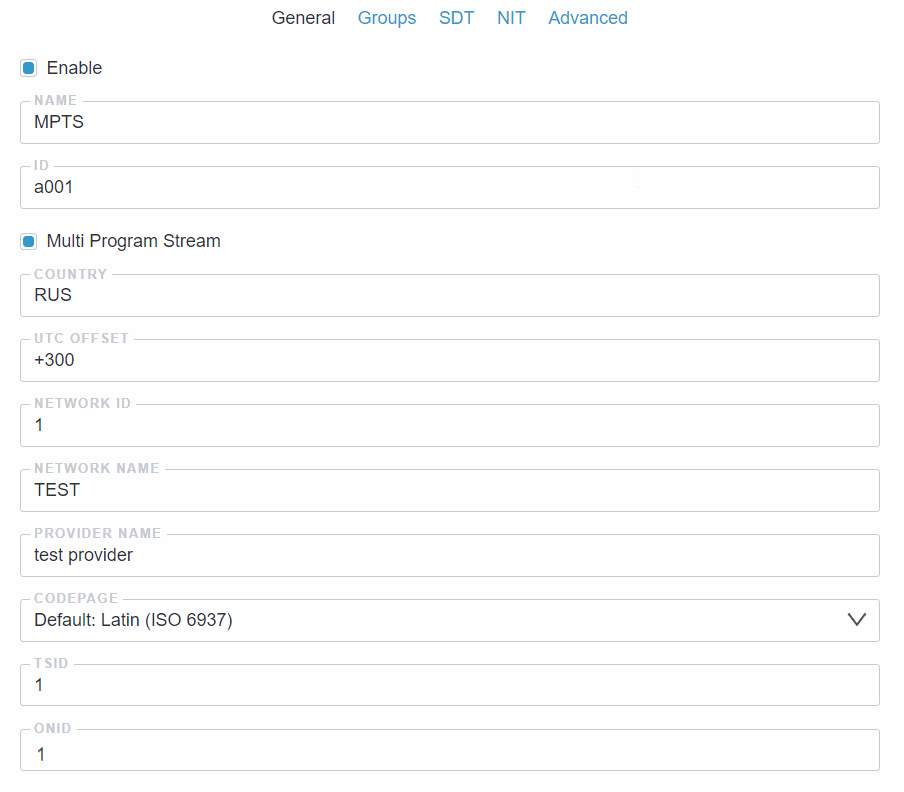
Definitions of items in a block:
Enable- this checkbox allows you to turn the connection to the modulator on or off. When enabled, the interface establishes a connection to the modulatorName- this parameter allows you to give the modulator an arbitrary name. The name you choose is used to identify the modulator in the Astra interface and can be any combination of letters, numbers, and special charactersID- This field is optional. ID is generated automatically when saving mptsCountry-this parameter sets the country in which the modulator will be used. The country you select determines the channel frequency plan that will be used by the modulator in the specification ISO 3166-1 alpha-3UTC Offset- this parameter sets the time offset from UTC in the range from -720 minutes to +780 minutes (used for generation of the tables TOT/TDT for auto time setting in the TV and the correct operation of the EPG)Network ID- this parameter is a unique identifier for the DVB network that the modulator belongs to. Default is: 1Network Name- this parameter is an arbitrary name for the DVB network that the modulator belongs toProvider Name- Used in NIT table (Network Information Table), which describes the information who owns the frequency, provider and network name. Is used to quickly identify the provider that owns the stream. For example this data we can see when scanning the frequency on the satelliteCodepage- this parameter is used to specify the character encoding used in the PSI/SI tables. For example, for English users it is Latin (ISO 6937)TSID- this parameter (Transport Stream ID) is a unique identifier for a DVB transport stream. It is used to differentiate between transport streams transmitted by different sources or with different content. Default is: 1ONID- this parameter refers to the Original Network ID, which is used to identify the originating network to which a channel belongs. It is a unique identifier assigned to a network, and is used in conjunction with the TSID to form a complete identifier for the transport stream. The ONID value must be the same for all transport streams within a given network. Default is: 1
Input List
The Input List in the General window is used to define input streams that will be used to modulate the output. It allows you to specify the transport stream, program number, and other parameters for each input stream. The Input List can be edited, added, or removed as needed
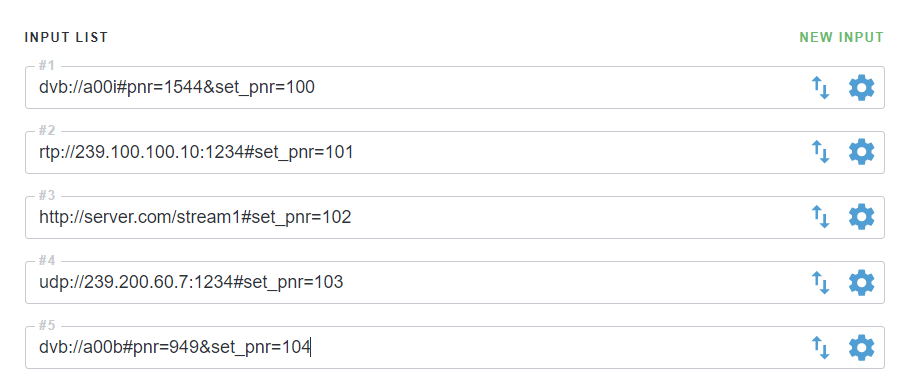
New Input- this button allows you to add a new input to the input list. Clicking on this button opens a new window where you can configure the parameters for the new input, such as its name, type, and modulation settingsArrows- еhis button is located on the right side of each input in the Input List. Clicking on it allows you to select the position of this input in the general listGear- this button is located on the right side of each input in the Input List and allows you to configure the parameters of that particular input. Clicking the "Gear" button will open a dialog box where you can modify the input's parameters, such as the input's type, bitrate, and modulation parameters
Streams included in mpts should not have repeated PIDs. It is also desirable to assign PNR numbers for each input with the set_pnr= option. For example:
udp://225.1.1.27:1234#set_pnr=11
udp://225.1.1.28:1234#set_pnr=12
udp://225.1.1.29:1234#set_pnr=13
Output List
The Output List section in the General window displays the list of outputs, which can be configured for the selected modulator. In this section, you can add or remove outputs and configure their settings. Each output in the list is represented by a row with its parameters and status displayed. The status of each output can be enabled or disabled using the corresponding checkbox in the first column of the output row

New Output- this button opens a new window where you can configure the parameters for the new output. The modulator number for the new output can be assigned based on the number of modulators in the adapter, starting from 0
Same as for the SPTS mode.
SDT
The SDT tab is a window that allows you to configure the Service Description Table, which is responsible for providing information about the services available in the transport stream. This information can include the service name, provider name, service type, and other details. In other words, the SDT tab provides a way to define and manage the services that will be available to viewers
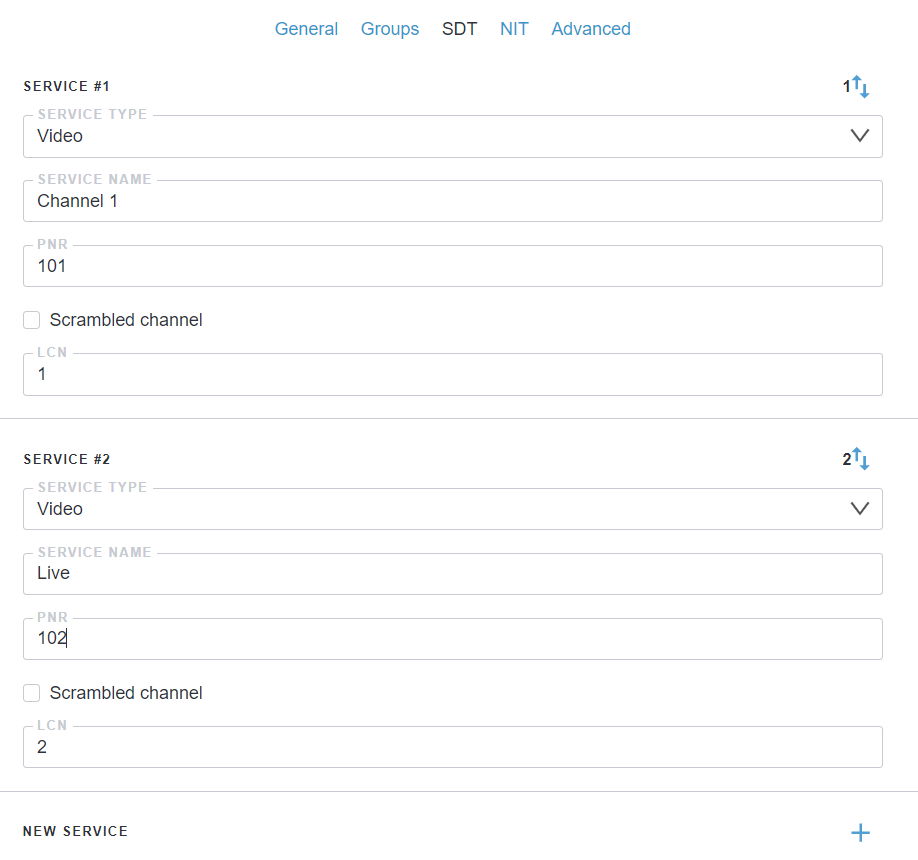
Service type- this parameter specifies the type of service that the user wants to configure, such as digital television, digital radio, or data servicesService name- this parameter refers to the name of the service that is being transmitted over the air. The service name is typically displayed on the user's TV or other receiving devicePNR- this parameter describes the Program number of the selected serviceScrambled channel- this parameter is a checkbox that indicates whether the selected channel is scrambled or not. When checked, it adds information to the channel description that the channel is encrypted. Modern dvb-receivers, focusing on this information, can display on the TV screen data that the channel is encryptedLCN- this parameter stands for Logical Channel Number. It is a unique identifier assigned to each channel or service in a digital broadcasting system
NIT
The "NIT" window allows you to define the network information table (NIT) for a custom modulator. The NIT contains information about the networks available to the user, such as the network ID, network name, and frequency
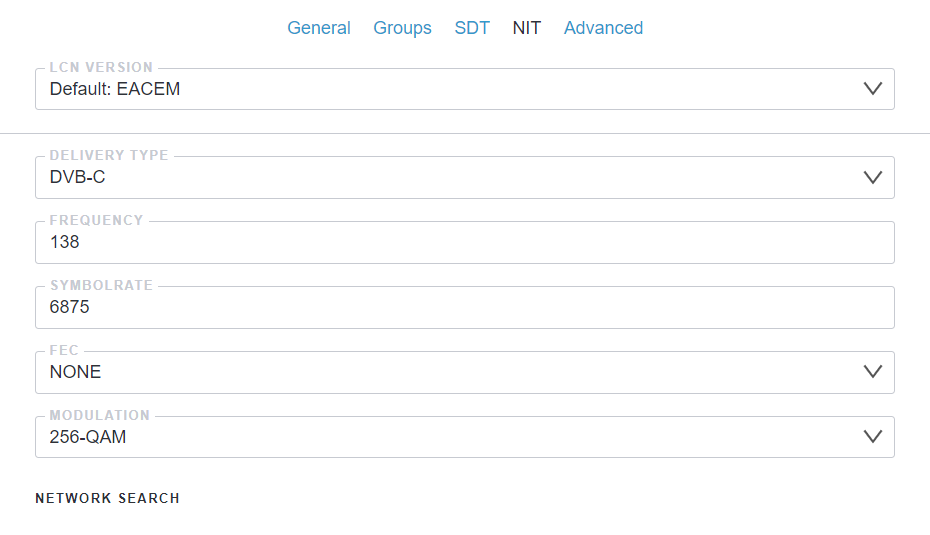
LCN Version- this parameter indicates the version number of the Logical Channel Number (LCN) table used by the service. The LCN table contains information about the ordering of services in a particular region or countryDelivery Type- this parameter defines the method used to deliver the signal for the selected serviceFrequency- this parameter determines the frequency of the output signal. It can be set in MHz (megahertz) and can have values ranging from 45 to 1002 MHz, depending on the delivery type selected for the modulatorSymbolrate- symbol rate. Specified in KBaudFEC- if your streams contain FEC, select the required value. Otherwise, select the default valueModulation- this parameter allows you to select the type of modulation to be used for the selected service
Network Search
Focusing on these parameters, modern dvb-tuner and TVs can perform the Quick Search. Not to perform on the set-top boxes and TV full channel search (which usually takes a long time), set up this simple and necessary service:
- Create all necessary mpts streams and fill in Delivery Type parameters in them. For example:
mpts_1 with frequency 378mpts_2 with frequency 386mpts_3 with frequency 394
- Go to settings mpts_1 and open the NIT tab. Check all related multiplexes
- Done!
How it works During the channel setup, the TV or STB finds the frequency 378, with
mpts_1, got theNITtables for all linked multiplexes and scan them fast.
Advanced tab
IThe Advanced tab contains special, advanced options for configuring MPTS
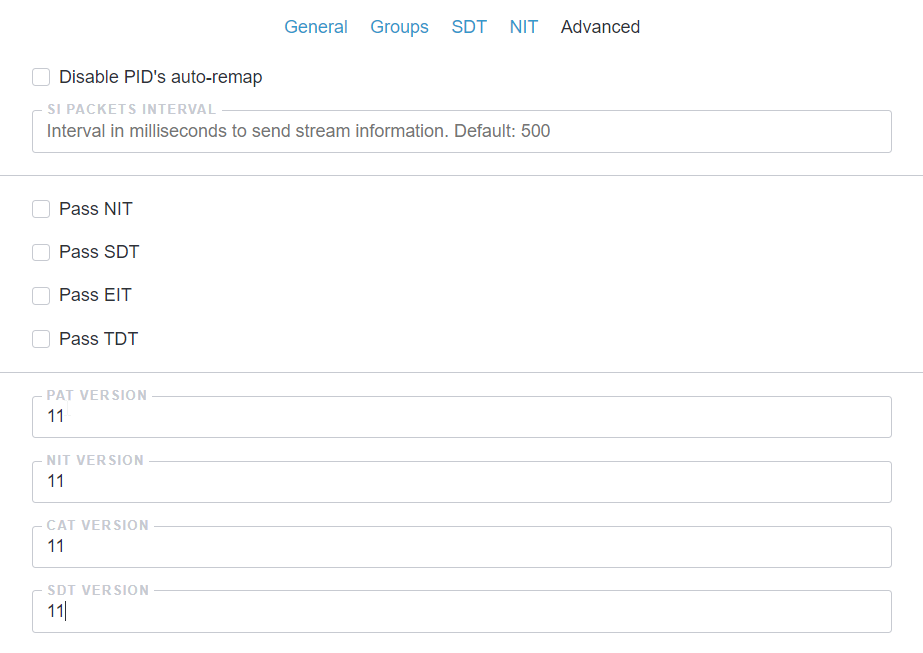
Disable PID's auto-remap- Disable automatic redefinition of PID numbers in MPTSSI packets interval- this is the interval for sending stream data. The default value is 500 milliseconds. This value does not need to be changedPass NIT/SDT/EIT/TDT- disables Astra processing of these tables. For example, tables are prepared by an external generatorPAT/NIT/CAT/SDT version- table version number. The number is incremented each time the mpts settings are updated. When the dvb receiver finds a change in the table number, it immediately re-reads it. There is no need to change the values manually